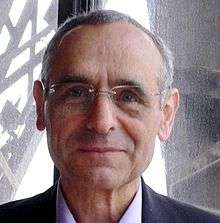Rémi Després
| Rémi Després | |
|---|---|
 | |
| Born |
January 16, 1943 Paris |
| Residence | France |
| Citizenship | France |
| Fields |
Data networks Computer science |
| Alma mater |
École polytechnique (France) UC Berkeley (California) |
| Known for |
RCP Transpac X.25 6rd |
Rémi Després (born January 16, 1943) is a French engineer and entrepreneur known for his contributions on Data networking.
Education
In 1961-1963, Rémi Després attended École Polytechnique of Paris, of which he holds an Engineer degree.
At UC Berkeley, he received a master's degree in 1967, and a Ph.D degree in 1969, both in the EECS Department.[1]
Career
From 1963 to 1971 at CNET and UC Berkeley, he specialized in programming languages and time-sharing operating systems.[2]
From 1971 to 1980, Rémi Després was in charge of R&D of the French PTT on packet switching. As such, he clarified and formalized the concept of Virtual Circuits. With his team at CNET, he validated it on the RCP experimental network.[3] He then successfully submitted for the X.25 Recommendation of CCITT, the standard of Data networks of the 1970s-1980's. He was the first Chief Technical Officer in charge of the French Transpac network whose X.25 service has been operational from 1978 to 2011.[4]
After working one year for Cap Gemini Sogeti, and four years for SESA,[5] Rémi Després founded in 1985 the LAN and Frame-Relay-products enterprise RCE,[6] a company acquired in 1996 by the CS Group.[7] In 1998, he founded a second startup, StreamCore SA, specialized in Quality of service management in TCP/IP, the Internet technology. When Streamcore SA was terminated in 2003, its StreamGroomer products were taken over by a new company, Streamcore Systems SA.
Since 2003, Rémi Després has been working as an independent researcher and consultant, mainly contributing to IETF to facilitate deployment of IPv6, the protocol that had become necessary to extend the number of customer addresses of Internet. In particular, he invented and promoted 6rd, a mechanism whereby FREE, an Internet Service Provider, deployed IPv6 service several years before similar network operators, and in only five weeks (RFC 5569, RFC 5969). Another notable contribution concerned 4rd, a technology to maintain a residual IPv4 service across IPv6-only networks (RFC 7600) .He also proposed a mechanism for Internet Service Providers to assign IPv6 addresses into customer sites that still have IPv4-only residential gateways (RFC 6751), with the distinctive feature that IPv6 traffic between devices of a same site remains within this site.[8] In 2011 Rémi Després and Alexandre Cassen received the Itojun Service Award[9] of the Internet Society for their IPv6 work.[10]
References
- ↑ "Electrical Engineering and Computer Science - UC Berkeley".
- ↑ "Algorithme d'Allocation d'Unité Centrale pour Calculateurs Exploités en Temps Partagé (CPU scheduling algorithm for time-shared computers)" (PDF).
- ↑ "RCP, The Experimental Packet-Switched Data Transmission Service of The French PTT".
- ↑ "X.25 Virtual Circuits - Transpac in France - Pre-Internet Data Networking".
- ↑ Société d'Etudes des Systèmes d'Automation (an X.25-switches company in France)
- ↑ Réseaux de Communication d'Entreprises SA (Enterprise-communication-networks company)
- ↑ "CS Group".
- ↑ "Native IPv6 Behind NAT44 CPEs (6a44)".
- ↑ "Itojun Service Award".
- ↑ "Alexandre Cassen and Rémi Després Recognized for Excellence in Advancing IPv6 Next-Generation Internet Protocol". ISOC Monthly Newsletter. ISOC. 2011-11-16.